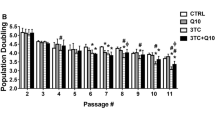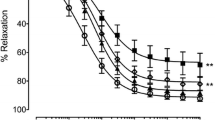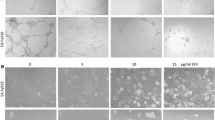Abstract
HIV-protease inhibitor (HIV-PI) drugs are critical for highly active antiretroviral therapy (HAART) efficacy, but several recent reports have suggested that metabolic and/or cardiovascular toxicities are associated with these drugs. Given the importance of the HIV-PI drug class and the widespread and chronic use of these agents in an expanding patient population, further understanding of this potential drug toxicity is imperative. Here, we investigated a role for direct endothelial toxicity induced by saquinavir (SAQ), the first HIV-PI drug marketed in the United States and still an important component of HAART therapies. In initial studies using isolated vascular tissues, we observed selective impairment of endothelium-dependent vasodilation with no effect on contractile responses. Subsequent studies using human endothelial cells in culture at clinically relevant concentrations (5 and 10 μM, 2–48 h), demonstrated concentration-dependent increases in cell death, mainly via apoptosis rather than necrosis (determined via Annexin-V positive membrane labeling). Live cell imaging also demonstrated increased intracellular oxidant production (as measured by DCF fluorescence), which could be abrogated by incubation with the antioxidant N-acetylcysteine (NAC). NAC also prevented SAQ-induced apoptotic cell death. These data demonstrate, that SAQ has direct toxicological effects on endothelial cells, and that the toxicity apparently involves apoptotic pathway activation via reactive oxygen and/or nitrogen species.
Similar content being viewed by others
References
Palella, F.J. Jr., Delaney, K.M., Moorman, A.C., Loveless, M.O., Fuhrer, J., Satten, G.A., et al. (1998). Declining morbidity and mortality among patients with advanced human immunodeficiency virus infection. HIV Outpatient Study Investigators. N. Engl. J. Med. 338:853–860.
Schapiro, J.M., Winters, M.A., Stewart, F., Efron, B., Norris, J., Kozal, M.J., et al. (1996). The effect of highdose saquinavir on viral load and CD4+ T cell counts in HIV-infected patients. Ann. Intern. Med. 124:1039–1050.
Isada, C.M. and Calabrese, L.H. AIDS update 1999 (1999). Viral reservoirs and immune-based therapies. Cleve. Clin. J. Med. 66:267–269.
Mouton, Y., Alfandari, S., Valette, M., Cartier, F., Dellamonica, P., Humbert, G., et al. (1997). Impact of protease inhibitors on AIDS-defining events and hospitalizations in 10 French AIDS reference centres. Federation National des Centres de Lutte contre le SIDA. AIDS 11:F101–105.
Deeks, S.G., Smith, M., Holodniy, M., and Kahn, J.O. (1997). HIV-1 protease inhibitors. JAMA 277:145–153.
Carr, A., Samaras, K., Thorisdottir, A., Kaufmann, G.R., Chisholm, D.J., and Copper, D.A. (1999). Diagnosis, prediction, and natural course of HIV-1 protease-inhibitor-associated lipodystrophy, hyperlipidaemia, and diabetes mellitus: a cohort study. Lancet 353:2093–2099.
Carr, A., Samaras, K., Chisholm, D.J., and Cooper, D.A. (1998). Pathogenesis of HIV-1-protease inhibitor-associated peripheral lipodystrophy, hyperlipidaemia, and insulin resistance. Lancet 351:1881–1883.
Domingo, P., Matias-Guiu, X., Pujol, R.M., Francia, E., Lagarda, E., Sambeat, M.A., et al. (1999). Subcutaneous adipocyte apoptosis in HIV-1 protease inhibitor-associated lipodystrophy. AIDS 13:2261–2267.
Tsiodras, S., Mantzoros, C., Hammer, S., and Samore, M. (2000). Effects of protease inhibitors on hyperglycemia, hyperlipidemia, and lipodystrophy. Arch. Intern. Med. 160:2050–2056.
Karmochkine, M. and Raguin, G. (1998). Severe coronary artery disease in a young HIV-infected man with no cardiovascular risk factor who was treated with indinavir. AIDS 12:2499–2514.
Jütte, A., Schwenk, A., Franzen, C., Römer, K., Fiet, F., Diehl, V., et al. (1999). Increasing morbidity from myocardial infarction during HIV protease inhibitor treatment? AIDS 13:1796–1797.
Koppel, K., Bratt, G., and Rajs, J. (1999). Sudden cardiac death in a patient on 2 years of highly active antiretroviral treatment: a case report. AIDS 13:1993–1994.
Behrens, G., Schmidt, H., Meyer, D., Stoll, M., and Schmidt, R.E. (1998). Vascular complications associated with use of HIV protease inhibitors. Lancet 351:1958–1960.
George, S.L., Swindells, S., Knudson, R., and Stapleton, J.T. (1999). Unexplained thrombosis in HIV-infected patients receiving protease inhibitors: report of seven cases. Am. J. Med. 107:624–626.
Eriksson, U., Opravil, M., Amann, F.W., and Schaffner, A. (1998). Is treatment with ritonavir a risk factor for myocardial infarction in HIV-infected patients? AIDS 12:2079–2080.
Meng, Q., Lima, J.A., Lai, H., Vlahov, D., Celentano, D.D., Strathdee, S., et al. (2002). Use of HIV protease inhibitors is associated with left ventricular morphologic changes and diastolic dysfunction. J. Acquir. Immune Defic. Syndr. 30:306–310.
Seminari, E., Pan, A., Voltini, G., Carevale, G., Maserati, R., Minoli, L., et al. (2002). Assessment of atherosclerosis using carotid ultrasonography in a cohort of HIV-positive patients treated with protease inhibitors. Atherosclerosis 162:433–438.
Friis-Moller, N., Weber, R., Reiss, P., Thiebaut, R., Kirk, O., d'Armonio Monforte, A., et al., and DAD study group. (2003). Cardiovascular disease risk factors in HIV patients —association with antiretroviral therapy. AIDS 17:1179–1193.
Behrens, G.M., Meyer-Olson, D., Stoll, M., and Schmidt, R.E. (2003). Clinical impact of HIV-related lipodystrophy and metabolic abnormalities on cardiovascular disease. AIDS 17(Suppl 1):S149–154.
Chironi, G., Escaut, L., Gariepy, J., Cogny, A., Teicher, E., Monsuez, J.J., et al. (2003). Brief report: carotid intima-media thickness in heavily pretreated HIV-infected patients. J. Acquir. Immune Defic. Syndr. 32:490–493.
Nolan, D., Watts, G.F., Herrmann, S.E., French, M.A., John, M., and Mallal, S. (2003). Endothelial function in HIV-infected patients receiving protease inhibitor therapy: does immune competence affect cardiovascular risk? Q. J. Med. 96:825–832.
Stein, J.H., Klein, M.A., Bellehumeur, I.L., McBride, P.E., Wiebe, d.A., Otvos, J.D., et al. (2001). Use of human immunodeficiency virus-1 protease inhibitors is associated with atherogenic lipoprotein changes and endothelial dysfunction. Circulation 104:257–262.
Friedl, A.C., Attenhofer Jost, C.H., Schalcher, C., Amann, F.W., Flepp, M., Jenni, R., et al. (2000). Acceleration of confirmed coronary artery disease among HIV-infected patients on potent antiretroviral therapy. AIDS 14:2790–2792.
de Gawtano, Donati, K., Rabagliati, R., Tumbarello, M., Tacconelli, E., Armore, C., et al. (2003). Increased soluble markers of endothelial dysfunction in HIV-positive patients under highly active antiretroviral therapy. AIDS 17:765–768.
Hoffmann, C. and Jaeger, H. (2001). Cardiology and AIDS-HAART and the consequences. Ann. NY Acad. Sci. 946:130–144.
Zhong, D-s., Lu, X-h., Conklin, B.S., Lin, P.H., Lumsden, A.B., Yao, Q., et al. (2002). HIV protease inhibitor ritonavir induces cytotoxicity of human endothelial cells. Arterioscler. Thromb. Vasc. Biol. 22:1560–1566.
Zietz, C., Hotz, B., Sturzl, M., Rauch, E., Penning, R., and Loh, U. (1996). Aortic endothelium in HIV-1 infection: chronic injury, activation, and increased leukocyte adherence. Am. J. Pathol. 149:1887–1898.
Paton, P., Tabib, A., Loire, R., and Tete, R.V. (1993). Coronary artery lesions and human immunodeficiency virus infection. Res. Virol. 144:225–231.
Tabib, A., Leroux, C., Mornex, J.F., and Loire, R. (2000). Accelerated coronary atherosclerosis and arteriosclerosis in young human-immunodeficiency-virus-positive patients. Coron. Artery Dis. 11:41–46.
Grunfeld, C., Kotler, D.P., Hamadeh, R., Tierney, A., Wang, J., and Pierson, R.N. (1989). Hypertriglyceridemia in the acquired immunodeficiency syndrome. Am. J. Med. 86:27–31.
Chaves, A.A., Mihm, M.J., Schanbacher, B.L., Basuray, A., Liu, C., Ayers, W., et al. (2003). Cardiomyopathy in a murine model of AIDS: evidence of reactive nitrogen species and corroboration in human HIV/AIDS cardiac tissues. Cardiovasc. Res. 60:108–118.
Wattanapitayakul, S.K. and Bauer, J.A. (2001). Oxidative pathways in cardiovascular disease: roles, mechanisms, and therapeutic implications. Pharmacol. Ther. 89:187–206.
Shimokawa, H. (1999). Primary endothelial dysfunction: atherosclerosis. J. Mol. Cell. Cardiol. 31:23–37.
Boulanger, C.M. (1999). Secondary endothelial dysfunction: hypertension and heart failure. J. Mol. Cell. Cardiol. 31:39–49.
Celermajer, D.S. (1997). Endothelilal dysfunction: does it matter? Is it reversible? J. Am. Coll. Cardiol. 30:325–333.
Drexler, H. and Hornig, B. (1999). Endothelial dysfunction in human disease. J. Mol. Cell. Cardiol. 31:51–60.
Wattanapitayakul, S.K., Weinstein, D.M., Holycross, B.J., and Bauer, J.A. (2000). Endothelial dysfunction and peroxynitrite formation are early events in angiotensin-induced cardiovascular disorders. FASEB J. 14:271–278.
Depairon, M., Chessex, S., Sudre, P., Rodondi, N., Doser, N., Chave, J.P., et al. (2001). Swiss HIV Cohort Study. Premature atherosclerosis in HIV-infected individuals—focus on protease inhibitor therapy. AIDS 15:329–334.
Plosker, G.L. and Scott, L.J. (2003). Saquinavir: a review of its use in boosted regimens for treating HIV infection. Drugs 63:1299–1324.
Turko, I.V. and Murad, F. (2002). Protein nitration in cardiovascular diseases. Pharmacol. Rev. 54:619–634.
Ischiropoulos, H. (1998). Biological tyrosine nitration: a pathophysiological function of nitric oxide and reactive oxygen species. Arch. Biochem. Biophys. 356:1–11.
Crow, J.P. (1997). Dichlorodihydrofluorescein and dihydrorhodamine 123 are sensitive indicators of peroxynitrite in vitro: implications for intracellular measurement of reactive nitrogen and oxygen species. Nitric Oxide—Biol. Ch. 1:145–157.
Cohen, I.S., Anderson, D.W., Virmani, R., Reen, B.M., Macher, A.M., Sennesh, J., et al. (1986). Congestive cardiomyopathy in association with the acquired immunodeficiency syndrome. N. Engl. J. Med. 315:628–630.
Pugliese, A., Isnardi, D., Saini, A., Scarabelli, T., Raddino, R., and Torre, D. (2000). Impact of highly active antiretroviral therapy in HIV-positive patients with cardiac involvement. J. Infect. 40:282–284.
Spada, C., Treitinger, A., Reis, M., Masokawa, I.Y., Verdi, J.C., Luiz, M.C., et al. (2002). The effect of N-acetylcysteine supplementation upon viral load, CD4, CD8, total lymphocyte count and hematocrit in individuals under-going antiretroviral treatment. Clin. Chem. Lab. Med. 40:452–455.
De Rosa, S.C., Zaretsky, M.D., Dubs, J.G., Roederer, M., Anderson, M., Green, A., et al. (2000). N-acetylcysteine replenishes glutathione in HIV infection. Eur. J. Clin. Invest. 30:915–929.
Royall, J.A. and Ischiropoulos, H. (1993). Evaluation of 2′–7′-dichlorofluorescin and dihydrorhodamine 123 as fluorescent probes for intracellular H2O2 in cultured endothelial cells. Arch. Biochem. Biophys. 302:348–355.
Mihm, M.J., Wattanapitayakul, S.K., Piao, S.F., Hoyt, D.G., and Bauer, J.A. (2003). Effects of angiotensin II on vascular endothelial cells: formation of receptor-mediated reactive nitrogen species. Biochem. Pharmacol. 65:1189–1197.
Author information
Authors and Affiliations
Corresponding author
Rights and permissions
About this article
Cite this article
Baliga, R.S., Liu, C., Hoyt, D.G. et al. Vascular endothelial toxicity induced by HIV protease inhibitor. Cardiovasc Toxicol 4, 199–206 (2004). https://doi.org/10.1385/CT:4:2:199
Received:
Revised:
Accepted:
Issue Date:
DOI: https://doi.org/10.1385/CT:4:2:199




